India Semiconductor Market Outlook to 2030
By Value-Chain Stage, By Device Type, By Process Node/Material, By End-Use Industry, By Wafer Size & Packaging, and By Region
- Product Code: TDR0246
- Region: Asia
- Published on: August 2025
- Total Pages: 110
Introducing the World's FirstPay-Per-Section Market Reports
Why pay for the full report when you need just a part?
Start Building Your Report
Scroll down to see available sections
Report Summary
The report titled “India Semiconductor Market Outlook to 2030 – By Value-Chain Stage, By Device Type, By Process Node/Material, By End-Use Industry, By Wafer Size & Packaging, and By Region” provides a comprehensive analysis of India’s semiconductor ecosystem. The study covers the overview and genesis of the industry, overall market sizing in value and capacity terms, and detailed market segmentation. The report evaluates trends and developments, the regulatory landscape, customer-level profiling, issues and challenges, and the competitive landscape including competition scenario, cross-comparison, opportunities and bottlenecks, and company profiling of major players across fabs/OSAT, fabless/design, materials, and equipment. The report concludes with future market projections to 2029 based on capacity and output indicators, product/technology mix, end-use pull, and regional build-out, using cause-and-effect linkages. It also includes success case studies that highlight key opportunities and cautions, providing an actionable playbook for investors, operators, and policymakers.
India Semiconductor Market Overview and Size
The India semiconductor market is valued at USD 6.80 billion, supported by solid historical growth data from 2019 to 2024. According to TraceData Research, this valuation is backed by credible industry studies. The market’s expansion is largely driven by accelerating demand in consumer electronics, 5G deployment, automotive electrification, and datacenter infrastructure, which have collectively created robust, quantifiable demand for semiconductors in both value and volume.
Dominant centers include Bengaluru, Hyderabad, and Pune, along with the emerging Uttar Pradesh corridor. The southern cities lead due to their deep IT and electronics design ecosystems, world-class R&D institutions, and proximity to global design partners . Meanwhile, Uttar Pradesh is rapidly rising in prominence thanks to favorable electronics manufacturing policies, infrastructure development, and strategic investments like the HCL–Foxconn facility near Jewar and the Uttar Pradesh Electronics Manufacturing Policy.
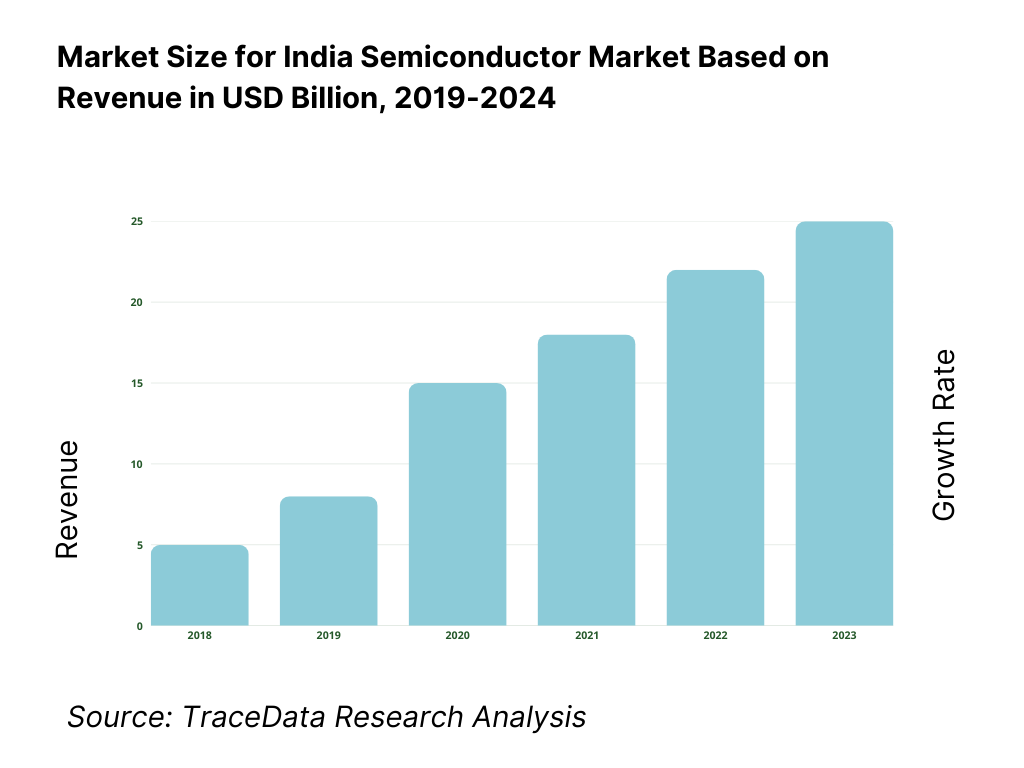
What Factors are Leading to the Growth of the India Semiconductor Market:
Policy firepower & design-to-manufacturing push: India has switched on large public financing specific to chips, which reduces entry risk for fabs and ATMP/OSAT. The India Semiconductor Mission carries an outlay of ₹76,000 crore, with program documents specifying fiscal support and a dedicated implementation structure. In parallel, the Design Linked Incentive has already sanctioned 23 chip-design projects, signalling a funded pipeline from IP to SoCs. Complementary electronics schemes are disbursing capital today—MeitY reports ₹2,377.06 crore released to 141 applicants under manufacturing cluster programs. Together, these numbers show both upfront capex support and design-ecosystem seeding—critical for India’s semiconductor market to localize higher value-add.
Demand pull from scaled digital and device adoption: Domestic demand anchors wafer starts and assembly utilization. India had 1,165.49 million wireless subscribers on record as of end-March (TRAI), a base already using data-heavy apps that lift device and network silicon consumption. Network modernization is visible in physical infrastructure: the Department of Telecommunications reports over 4.62 lakh 5G base stations installed, expanding radios, backhaul and core demand for RF, memory and logic. On the trade side, India shipped US$29.12 billion of electronic goods in the latest fiscal, indicating deepening domestic manufacturing linkages that also consume components and ICs. This scale effect is a structural driver for India’s semiconductor market—from handset and network silicon to power devices for infrastructure.
Electrification of mobility & power electronics pull-through: Electrified transport is now a visible, quantified load on semiconductor content in India. Government records show 4,574,938 electric vehicles registered on the e-Vahan portal by late July, with a clear step-up in registrations through the previous fiscal. EV traction in two-/three-wheelers and buses expands demand for Si/SiC MOSFETs, IGBTs, MCUs and battery-management ICs—adjacent to chargers and DC-DC converters. This sits within a macro economy sized at US$3,912,686.17 million (current US$) and rising manufacturing activity, offering headroom for domestic componentization and local test/pack. The combination of EV stock and a large macro base creates steady orders for power, analog and embedded silicon across India’s semiconductor market.
Which Industry Challenges Have Impacted the Growth of the India Semiconductor Market:
Import-heavy electronics supply chain exposes the chip ecosystem: While electronics exports are rising, India’s overall merchandise imports remain very large, and the sector is still reliant on inbound parts and equipment. Government trade releases detail fiscal-year import and export values, underscoring the magnitude of goods flows that include HS-85 components, specialty gases, photolithography gear and precision spares essential for fabs and ATMP/OSAT. Customs performance has improved yet remains a planning constraint for critical-path logistics: CBIC’s National Time Release Study reports average import release times of 85:42 hours at seaports, 71:46 hours at ICDs, 44:16 hours at air cargo complexes, and 31:47 hours at integrated check posts. For semiconductor projects with tight MRO cycles, these absolute hours shape safety stocks and downtime risk.
Water stress and environmental clearances for water-intensive nodes: Modern fabs can require thousands of cubic meters of ultra-pure water daily; that collides with India’s quantified water stress. The Ministry of Jal Shakti cites 1,486 cubic meters of average annual per-capita water availability for the reference year and 1,367 cubic meters for the subsequent decade benchmark—both within “water-stressed” thresholds. Such baselines force semiconductor investors to model zero-liquid-discharge, wastewater recycling, and multi-source raw water tie-ups before consent-to-establish/operate is granted by State Boards. In practice, these numbers mean fab sites must co-opt treated municipal flows and industrial effluent reuse to secure resilient daily supply without crowding out urban and agricultural demand.
Talent depth in VLSI specialties versus broad STEM output: India’s higher-education pipeline is vast, but the semiconductor-specific slice is narrower than total STEM. The Ministry of Education’s AISHE statistical release notes 9.85 million STEM enrolments across UG/PG/M.Phil./Ph.D. in the latest reported cycle and 10.7 million total pass-outs across disciplines—large figures for a design ecosystem. Yet advanced nodes, analog layout, DFT, EDA flows, and packaging require concentrated experience that takes years to build. Without scaled tap-roots into postgraduate microelectronics and sustained industry–lab co-ops, many graduates detour into software or IT services; the macro enrolment and pass-out numbers demonstrate supply, but the semiconductor market’s need is depth in niche skills that remain capacity-constrained.
What are the Regulations and Initiatives which have Governed the Market:
India Semiconductor Mission (ISM) – program structure and fiscal support: The ISM anchors approvals for fabs, displays, compound semiconductors and ATMP/OSAT under a ₹76,000 crore central outlay. Official program communications specify scheme contours (application appraisal by Expenditure Finance Committee, fiscal support on a pari-passu basis, and project-level conditions). Recent press notes show active project pipelines across multiple states, indicating the licensing corridor is operational—MoUs, evaluation, and Cabinet approvals where required. For market participants, the numeric outlay and program structure translate to credible center-state coordination, viability-gap cover, and a path to secure land, utilities and fiscal closure within a defined window.
Design Linked Incentive (DLI) – funded pipeline of chip design: DLI provides reimbursable support alongside shared EDA IP/compute access through the chips-DLI platform. Government disclosures confirm 23 sanctioned chip-design projects, spanning surveillance camera SoCs, energy-meter silicon and microprocessor IPs—tying financial support to verifiable design milestones. This numeric base matters operationally: sanctioned teams can progress from RTL to tape-out using subsidized tools and MPW runs, and later link to manufacturing schemes for NPI. For the India semiconductor market, DLI’s measurable pipeline de-risks early-stage IP creation and creates investable assets for OSATs and fab partners.
Complementary electronics manufacturing schemes – PLI/SPECS/EMC: Semiconductor projects depend on upstream/downstream electronics. Under the electronics policy stack, the government has notified PLI for large-scale electronics and IT hardware, the Scheme for Promotion of Manufacturing of Electronic Components and Semiconductors (SPECS), and Electronics Manufacturing Clusters 2.0. Official releases document real disbursal: ₹2,377.06 crore issued to 141 applicants in cluster schemes, while PLI budgets notified by Parliament answers detail ₹34,193 crore for large-scale electronics and ₹17,000 crore for IT hardware. These concrete rupee outlays and beneficiaries compress supply-chain setup times for substrates, PCBs, passives and fixtures that semiconductor units rely on.
India Semiconductor Market Segmentation
By Device Type: The India semiconductor market is segmented by device type into Logic, Memory, Analog & Mixed-Signal, Discrete, and Sensors & Opto. The Analog & Mixed-Signal segment holds a dominant share of the market. This dominance stems from its pervasive use in power management, sensor interfacing, and analog front ends across key growth sectors such as automotive, smartphones, and IoT devices. Its strategic role in device integration and differentiation across mobile, automotive, and industrial systems underscores its leading position.
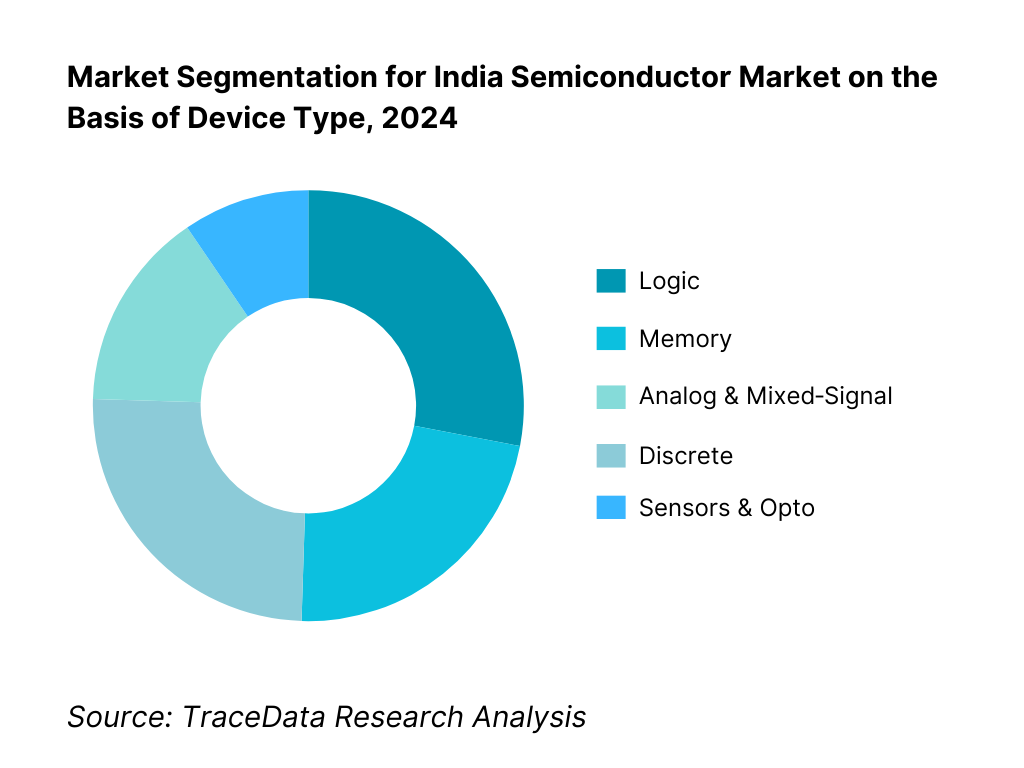
By End-Use Industry: The India semiconductor market is segmented by end-use industry into Consumer Electronics, Automotive & EV, Telecom & Networking, IT/Datacenter, and Industrial/IoT. Consumer Electronics dominate due to India’s massive smartphone and smart device market, with over 650 million smartphone users, combined with increased affordability and brand penetration. The consistent demand for display, power management, and RF front‑end chips among OEMs and ODMs cements this segment’s market leadership.
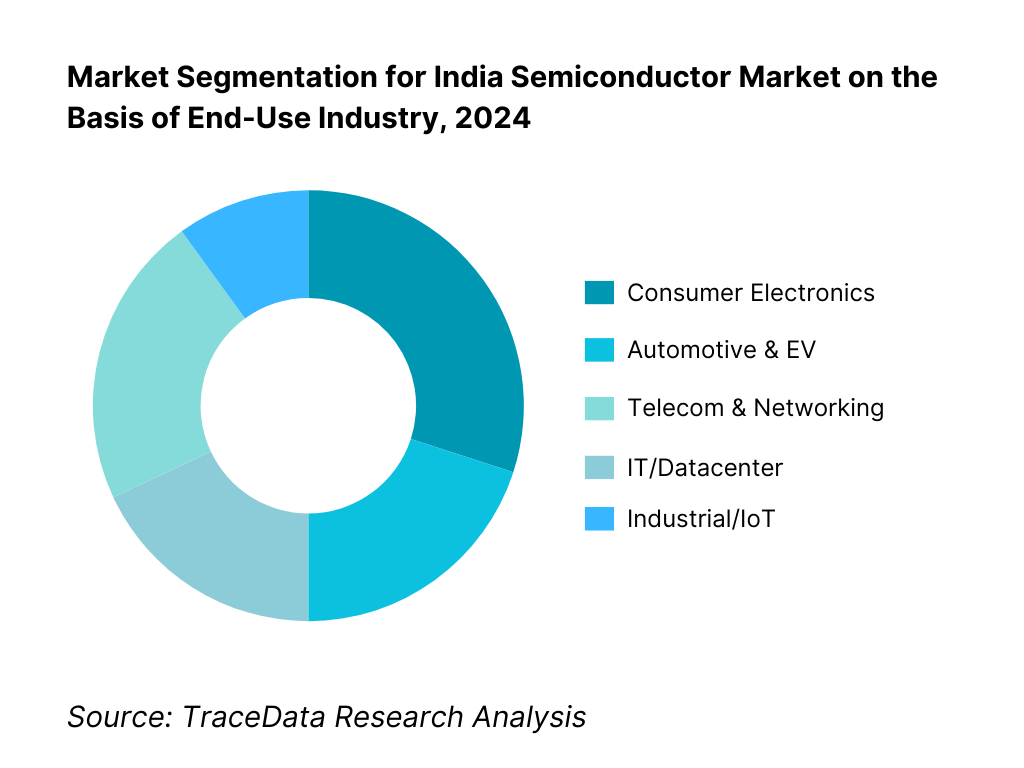
Competitive Landscape in India Semiconductor Market
India's semiconductor market is shaping up with a diverse set of emerging and established players, blending domestic initiatives with global partnerships. The India semiconductor market features a mix of ambitious Indian groups and international firms establishing a foothold via JV’s, OSAT and design services. This consolidation highlights the strategic influence of key players shaping the ecosystem.
Name | Founding Year | Original Headquarters |
Tata Electronics (TEPL) | 2020 | Bengaluru, India |
Micron Technology | 1978 | Boise, Idaho, USA |
Kaynes Technology India | 2008 | Mysuru, India |
CG Power & Industrial Solutions | 1937 | Mumbai, India |
Continental Device India (CDIL) | 1964 | New Delhi, India |
SPEL Semiconductor | 1984 | Chennai, India |
Polymatech Electronics | 2007 | Kancheepuram, India |
Sahasra Electronics | 2000 | New Delhi, India |
MosChip Technologies | 1999 | Hyderabad, India |
Signalchip Innovations | 2010 | Bengaluru, India |
Tessolve Semiconductor | 2004 | Bengaluru, India |
Sankalp Semiconductor | 2005 | Hubli, India |
Tata Elxsi | 1989 | Bengaluru, India |
Renesas Electronics | 2010 | Tokyo, Japan |
Semi-Conductor Laboratory (SCL) | 1976 | Mohali, India |
Some of the Recent Competitor Trends and Key Information About Competitors Include:
Tata Electronics: As one of the most ambitious domestic entrants in the semiconductor ecosystem, Tata Electronics has advanced its OSAT project in Tamil Nadu while securing technology transfer partnerships for logic and display driver packaging. The company’s focus on large-scale assembly and test capacity marks a strategic step toward reducing import dependence.
Micron Technology India: Micron inaugurated its large ATMP facility in Sanand, Gujarat, strengthening India’s position in global memory packaging. The site is designed for DRAM and NAND assembly and test operations, aimed at catering to the surging datacenter and smartphone demand.
Kaynes SemiCon: Known for its strong focus on advanced packaging, Kaynes SemiCon expanded its footprint in Gujarat and Karnataka. The company is emphasizing FC-BGA and WLCSP technologies to serve the fast-growing automotive and industrial segments.
CG Power Semiconductors JV: Backed by CG Power, Renesas, and Stars Microelectronics, the JV has moved rapidly toward establishing a state-of-the-art OSAT facility in Sanand. This project is positioned as a cornerstone in India’s semiconductor mission, supported by substantial central and state incentives.
Polymatech Electronics: Specializing in wide-bandgap materials, Polymatech expanded its GaN and SiC component production in Tamil Nadu. Its investments in power semiconductors are strategically aligned with the growth of India’s EV and renewable energy sectors.
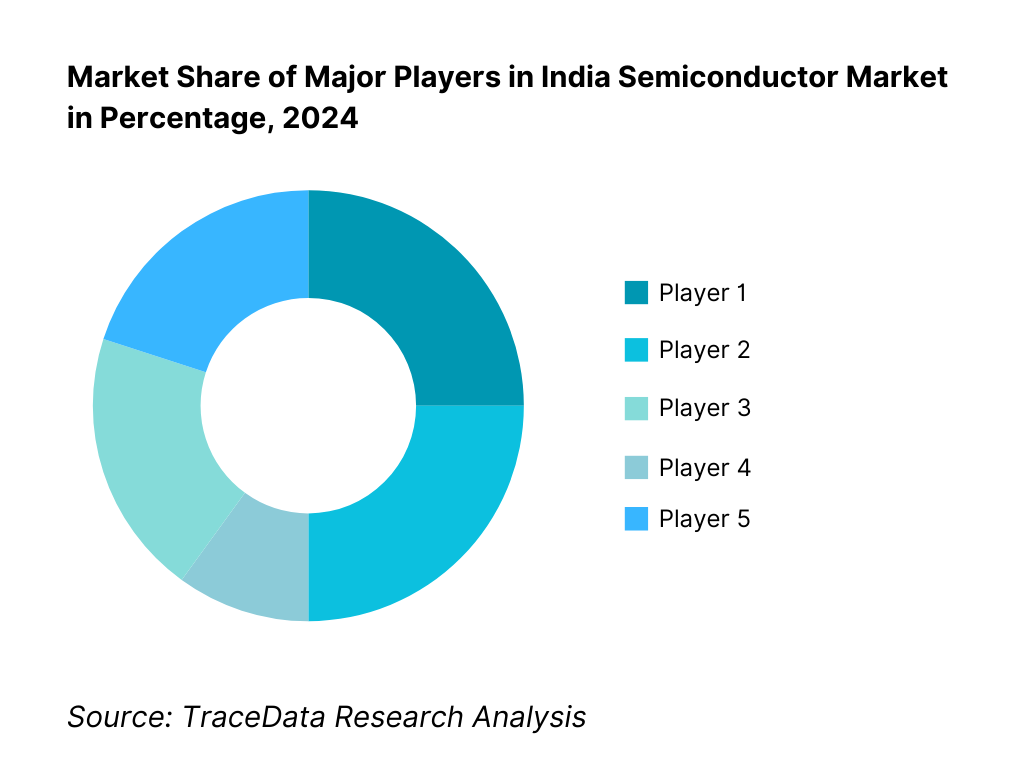
What Lies Ahead for India Semiconductor Market?
The India semiconductor market is expected to strengthen its role in the global supply chain, supported by government-backed incentives, increasing local demand from electronics and EV industries, and strategic partnerships with global technology leaders. The ecosystem is gradually moving from being import-reliant to developing a robust domestic design-to-manufacturing pipeline, which will be critical for reducing external vulnerabilities and meeting the growing consumption base in the country.
Rise of Domestic Assembly & Test Ecosystem: India is likely to witness rapid expansion in ATMP/OSAT units as companies like Micron, Tata Electronics, Kaynes SemiCon, and CG Power Semiconductors JV set up large-scale operations. This will help reduce dependence on overseas test facilities and bring higher value capture within the country.
Focus on Wide-Bandgap Materials: With the strong momentum in electric mobility and renewable energy integration, demand for SiC and GaN semiconductors is set to rise. Players like Polymatech and other new entrants focusing on wide-bandgap technologies will be at the forefront of supplying power electronics solutions required for EVs, charging infrastructure, and clean energy grids.
Strategic Partnerships & Technology Transfers: The next decade will be marked by joint ventures and technology transfers from established hubs like Taiwan, Japan, and the US. Partnerships such as Tata–PSMC and CG Power–Renesas are already shaping India’s semiconductor landscape, enabling faster adoption of mature nodes while gradually building design and R&D capacity in advanced logic and packaging.
Integration of AI & RISC-V Design Capabilities: India’s semiconductor design community is set to leverage AI-driven design automation and the global momentum around open-source RISC-V architecture. This shift will not only enhance local innovation but also provide a scalable path for startups and fabless companies to deliver globally competitive solutions.
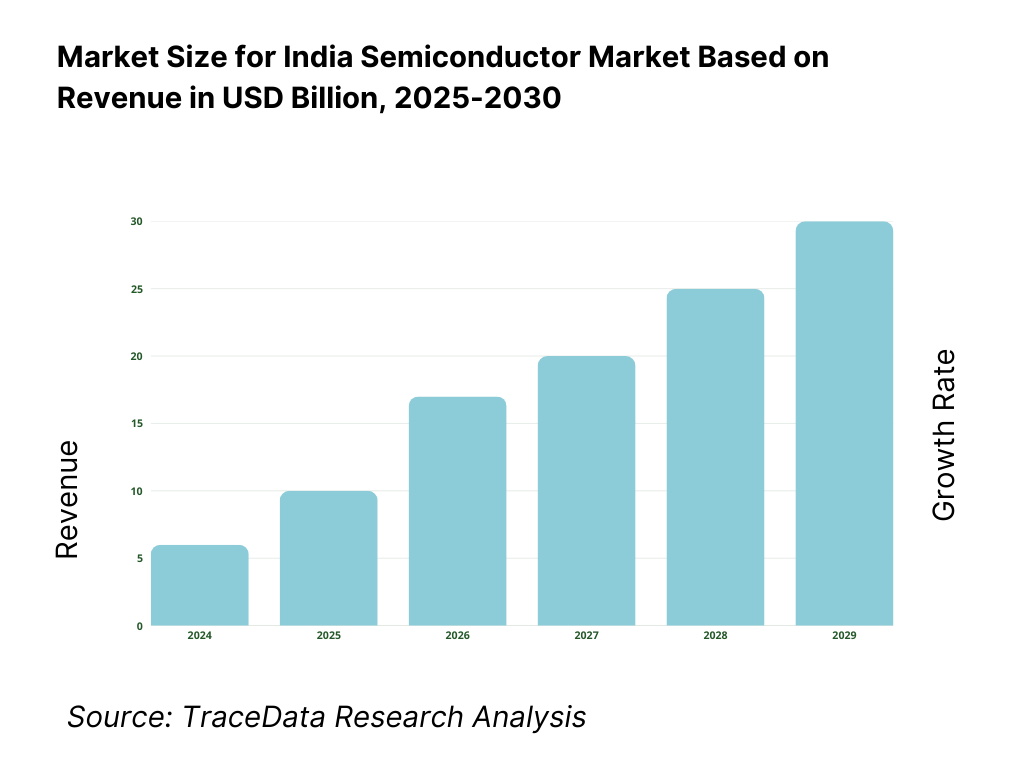
India Semiconductor Market Segmentation
By Value-Chain Stage
Fabless Design
Wafer Fabrication
ATMP/OSAT (Assembly, Testing, Marking, Packaging)
Materials & Substrates
Equipment & Metrology
By Device/Technology Type
Logic ICs
Memory ICs
Analog & Power Devices
Discrete & Sensor ICs
Wide-Bandgap Devices (SiC, GaN)
By End-Use Industry
Automotive & EV
Consumer Electronics & Smartphones
Telecom & 5G Networking
Datacenter & Cloud/AI Infrastructure
Industrial & IoT
Defense & Strategic Electronics
By Wafer/Packaging Format
Wafer Size (150 mm, 200 mm, 300 mm)
Packaging Formats (QFN/QFP, FC-BGA, WLCSP, SiP, 2.5D/3D)
By Region
Gujarat
Uttar Pradesh
Karnataka
Tamil Nadu
Telangana
Others
Players Mentioned in the Report:
Tata Electronics (TSAT)
Micron Technology India
Kaynes SemiCon
CG Power Semiconductors (JV)
HCL–Foxconn JV
SPEL Semiconductor
Continental Device India (CDIL)
Polymatech Electronics
MosChip Technologies
Signalchip Innovations
Tessolve
HCLTech – Sankalp Semiconductor
Tata Elxsi
Renesas Electronics India
Key Target Audience
Semiconductor Fabricators & OSAT Operators
Electronics OEMs & EMS providers
State Government Policy & Planning Bodies
Central Government Agencies
Venture Capital & Investment Firms specializing in deep tech or hardware startups
Corporate Strategic Investment Departments
Global Semiconductor Tool & Equipment Suppliers
Automotive OEM Electronics Procurement Heads
Time Period:
Historical Period: 2019-2024
Base Year: 2025
- Forecast Period: 2025-2030
Report Coverage
Choose individual sections to purchase. Mix and match as you like.
- -
- -
- $100
4.1. Delivery Model Analysis for Semiconductor Manufacturing (Wafer Fab, ATMP/OSAT, Fabless Design, Foundry)-Discussing Margins, Preference, Strengths & Weaknesses
4.2. Revenue Streams for India Semiconductor Market (Foundry Revenues, Packaging/Testing, Design Services, IP Licensing, EMS/ODM Integration)
4.3. Business Model Canvas for India Semiconductor Market (IDM, Foundry, Fabless, OSAT, JV/Tech Transfer Models)
$2505.1. Domestic Players vs Global MNCs in Indias Semiconductor Ecosystem
5.2. Investment Model in India Semiconductor Market (Greenfield Fab, Brownfield Modernization, ATMP/OSAT Expansion)
5.3. Comparative Analysis of Funding & Approval Processes-Private vs Government-Led Initiatives (PLI, DLI, ISM)
5.4. Capital Allocation Trends by Project Scale (Mega-Fabs, Mid-Size ATMPs, Fabless Startups)
$1506.1. End-Use Growth Potential (Automotive, Consumer Electronics, Telecom, Industrial, Datacenter/AI)
6.2. Value-Addition Potential by Stage (Fab, Packaging, Design, Materials)
6.3. State-Level Attractiveness (Gujarat, UP, Karnataka, Tamil Nadu, Telangana)
$1007.1. Installed Wafer Starts Per Month (WSPM) vs Domestic Demand
7.2. Packaging/Testing Units vs Assembly Demand
7.3. Import Dependence on Strategic Nodes and Device Types
7.4. Critical Gaps in Materials & Substrates
$2008.1. Revenues (USD Bn & INR Cr, Historical and Current)
8.2. Installed Capacity (WSPM, UPH)
8.3. Import Dependence and Leakage Value
$3009.1. By Market Structure (Fabless, Foundry, IDM, OSAT, Design Services)
9.2. By Device Type (Logic, Memory, Analog & Mixed-Signal, Discrete, Sensors & Opto)
9.3. By End-Use Industry (Automotive, Consumer Electronics, IT/Datacenter, Telecom, Industrial/IoT)
9.3.1. By Automotive Semiconductors (MCUs, SiC/GaN Power, Sensors)
9.3.2. By Datacenter/AI Chips (Accelerators, Memory, Retimers)
9.3.3. By Consumer Electronics (APs, RF, PMICs, CIS)
9.3.4. By Industrial IoT Chips (MCUs, Connectivity, Analog Power)
9.4. By Company Size (Large IDMs, Mid-Sized OSATs, Emerging Fabless Startups)
9.5. By Workforce Designation (VLSI Design, Process Engineers, Equipment Technicians, QA/Testing)
9.6. By Mode of Engagement (Foundry, OSAT, Design Services, EMS/ODM Sourcing)
9.7. By Open vs Proprietary Tech Transfer Programs
9.8. By Region (Gujarat, UP, Karnataka, Tamil Nadu, Telangana, Others)
$40010.1. OEM/ODM Client Landscape and Cohort Analysis (Automotive, Smartphone, Datacenter, Telecom)
10.2. Semiconductor Sourcing Needs and Decision-Making Process (node choice, packaging preference, supplier selection)
10.3. ROI & Effectiveness Analysis of Local vs Imported Chips
10.4. Gap Analysis Framework for Technology Access, Yield Ramp & Reliability
$50011.1. Trends and Developments (28/40nm Focus, Advanced Packaging, Chiplet Design, RISC-V Momentum)
11.2. Growth Drivers (PLI/DLI Incentives, EV Adoption, 5G Rollout, AI Datacenter Expansion, Defense/Space Needs)
11.3. SWOT Analysis for India Semiconductor Market
11.4. Issues and Challenges (High Capex, Yield Ramp Risk, Talent Shortages, Utilities Reliability)
11.5. Government Regulations (PLI, DLI, Customs Duties, Trusted Foundry Requirements)
$20012.1. Market Size and Future Potential for EDA & Design Services in India
12.2. Business Models & Revenue Streams (Design-as-a-Service, IP Licensing, MPW Shuttles)
12.3. Delivery Models and Tape-Out Courses/Programs Offered
12.4. Cross Comparison of Leading Semiconductor Design Firms (Company Overview, Investment, Revenues, IP Portfolio, Tape-Outs, Technology Focus, Clients)
$500- $250
- $150
15.1. Market Share of Key Players in India Semiconductor Market (By Value-Chain Stage & Revenue)
15.2. Benchmark of Key Competitors including Tata Electronics, Micron India, Kaynes SemiCon, CG Power Semi JV, Polymatech, CDIL, Sahasra Semi, MosChip, Signalchip, Tessolve, HCLTech-Sankalp, Tata Elxsi, Renesas India, SPEL Semi, Continental Device India-covering Company Overview, USP, Business Model, Revenues, Technology Portfolio, Strategic Tie-Ups, Major Clients, Marketing Strategy, and Recent Developments
15.3. Operating Model Analysis Framework (Foundry, Fabless, IDM, OSAT)
15.4. Gartner Magic Quadrant Positioning (Adapted to Semiconductor Value-Chain)
15.5. Bowmans Strategic Clock for Competitive Advantage in India Semiconductor
$75016.1. Revenues (Projections)
16.2. Installed Wafer Capacity & Packaging Output (WSPM, UPH)
$30017.1. By Market Structure (Fabless, Foundry, IDM, OSAT, Design Services)
17.2. By Device Type (Logic, Memory, Analog & Mixed-Signal, Discrete, Sensors & Opto)
17.3. By End-Use Industry (Automotive, Consumer Electronics, IT/Datacenter, Telecom, Industrial/IoT)
17.3.1. By Automotive Semiconductors (MCUs, Power Devices, SiC/GaN)
17.3.2. By Datacenter/AI Chips (Accelerators, Memory, Interconnect)
17.3.3. By Consumer Electronics (APs, RF, PMICs, CIS)
17.3.4. By Industrial IoT Chips (MCUs, Connectivity, Analog Power)
17.4. By Company Size (Large IDMs, Mid-Sized OSATs, Emerging Startups)
17.5. By Workforce Designation (VLSI, Process, Testing)
17.6. By Mode of Engagement (Foundry, OSAT, Design Services, EMS)
17.7. By Open vs Proprietary Programs (JV Models, Licensing)
17.8. By Region (State-Wise Analysis)
$400- $250
- $250
Research Methodology
Step 1: Ecosystem Creation
Map the full India Semiconductor Market ecosystem across demand and supply. Demand-side: automotive OEMs/tiers, smartphone/consumer electronics OEMs/ODMs/EMS, datacenter & cloud operators, telecom operators & network OEMs, industrial/IoT device makers, defense/space agencies, and major distributors. Supply-side: fabless design houses, IP providers, EDA vendors, wafer fabs (legacy, analog, specialty, compound), ATMP/OSAT units, substrate/leadframe makers, chemicals & specialty gases, equipment OEMs/field-service providers, reliability labs, logistics & utilities partners, and policy/incentive bodies (MeitY/ISM, state nodal agencies). From this map, shortlist 5–6 priority companies (e.g., OSAT/fabless/IDM/design-services) using screens on audited financials, booked capex, installed/announced WSPM or UPH, client rosters, certifications (AEC-Q100/IATF-16949), export footprints, and state/central scheme traction. Sourcing: government portals, gazette/press notes, investor filings, EPC/RFP documents, trade filings, and proprietary databases.
Step 2: Desk Research
Conduct exhaustive desk research using diversified secondary and proprietary sources to build a fact base. Market-level: end-use electronics output, import/export by HS-85 lines, announced fab/ATMP projects, node mix (≥65/45–28/≤22 nm buckets), package mix (QFN/QFP/FC-BGA/WLCSP/SiP), certification penetration, and reliability/quality benchmarks. Company-level: revenues by segment, customer mix, tooling & metrology fleets, technology partnerships/PDKs, yield ramp narratives, facility utilities (power MVA, water MLD, CDA/N₂), and EHS/ESG disclosures. Evidence pack sources include: annual reports, financial statements, investor presentations, MoUs/cabinet notes, land allotment letters, incentive disbursal updates, site-commissioning photos, RFPs/BoQs, and shipping/manifests intelligence. The objective is a consistent dataset for sizing, capacity modeling (WSPM, UPH, handler/ATE utilization), and competitive positioning.
Step 3: Primary Research
Run structured interviews with C-suite/VPs across fabs/OSAT, fabless, design-services, equipment OEMs, materials suppliers, distributors, and large buyers (automotive electronics, handset, datacenter, telecom). Goals: validate desk-built hypotheses, triangulate operational KPIs (die yield, assembly yield, test time/TAT), confirm capex phasing and tool move-in, and clarify technology access (licensing/PDK scope). Engage state industrial agencies and utilities operators to confirm land, power, water, and effluent commitments. Apply a bottom-to-top build (per-site output = nameplate × utilization × yield) to estimate revenue contribution by player; reconcile with top-down demand (silicon content per system × units shipped domestically + export flows). As a validation layer, conduct buy-side conversations (procurement/engineering) and disguised RFQ-style interactions to corroborate quoted lead times, qualification gates, price–performance envelopes, packaging readiness, and reliability run-rates against secondary evidence.
Step 4: Sanity Check
Execute dual top-down vs bottom-up reconciliations.
Top-down: end-use device builds (smartphones, autos, base stations, servers, industrial) × silicon content (logic/analog/power/memory/RF) to derive implied IC demand and packaging/test hours; cross-check with import/export tallies and distributor sell-through.
Bottom-up: aggregate WSPM by node/wafer size and UPH by package type, applying realistic utilization, scrap, and yield curves from primaries; align with installed tools/shift patterns, utilities uptime SLAs, and qualification ramp calendars.
Stress-test with scenario levers: node mix shifts, EV electronics penetration, 5G site adds, substrate/chemicals localization, and export controls. Close gaps by re-contacting sources, updating assumption books, and issuing a methods & assumptions appendix to lock the final dataset and ensure traceability.
FAQs
01 What is the potential for the India Semiconductor Market?
The India Semiconductor Market is poised for substantial expansion as multiple green-lit projects move from approvals to execution. The Union Cabinet has cleared marquee proposals—Micron’s assembly & test facility in Sanand, Gujarat; Tata Electronics’ fab at Dholera with a global tech partner; CG Power–Renesas–STARS’ OSAT in Sanand; and an HCL–Foxconn OSAT near Jewar, Uttar Pradesh—under the India Semiconductor Mission (ISM) with a central outlay of ₹76,000 crore. Together, these units anchor domestic capacity creation in fab and advanced packaging while crowding-in supply-chain investments across materials, equipment, and skills.
02 Who are the Key Players in the India Semiconductor Market?
Key participants include Tata Electronics (fab/OSAT), Micron Technology India (ATMP/OSAT, DRAM & NAND), CG Power Semiconductors JV with Renesas & STARS (OSAT), HCL–Foxconn JV (OSAT, display driver chips), Kaynes SemiCon (advanced packaging), SPEL Semiconductor (OSAT), Polymatech (wide-bandgap devices), Continental Device India (discretes), MosChip and Signalchip (fabless design), Tessolve and HCLTech–Sankalp (design/test), Renesas India (R&D/partnerships), and SCL (government fab). The prominence of these firms stems from sanctioned projects, technology-transfer partnerships, and state/central incentive traction that collectively shape domestic capacity and ecosystem depth.
03 What are the Growth Drivers for the India Semiconductor Market?
Three forces stand out. First, policy firepower: ISM’s ₹76,000-crore outlay and related approvals provide fiscal support and a licensing path for fabs, OSATs, and compound-semiconductor units. Second, clear demand pull: nationwide electronics manufacturing and deployments in connectivity and compute are intensifying—illustrated by the rapid approval and construction of multiple chip facilities and the clustering effect around Sanand and Dholera. Third, electrification and digitalization across mobility, telecom, and cloud are expanding silicon content per system, where domestic ATMP/OSAT ramps (e.g., Micron Sanand) can localize value-add and shorten lead times.
04 What are the Challenges in the India Semiconductor Market?
Execution risk and time-to-ramp remain central: fabs and advanced packaging lines require complex tool move-ins, utilities (power, water, gases), and multi-stage qualifications before volume output. Supply-chain depth—substrates, specialty gases, and critical spares—must scale domestically to cut import-linked delays; any logistics lag can impede uptime for high-mix OSAT operations. Finally, sustained access to process technologies and specialized talent is essential: JV/tech-transfer agreements (e.g., Tata–PSMC, CG Power–Renesas) mitigate know-how barriers, but repeatable yields and reliability benchmarking will hinge on steady skills pipelines and on-ground vendor ecosystems across approved sites.